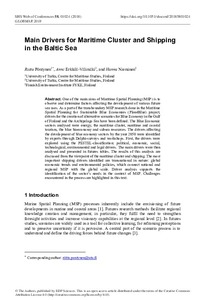Main Drivers for Maritime Cluster and Shipping in the Baltic Sea
Riitta Pöntynen; Anne Erkkilä-Välimäki; Hanna Nieminen
https://urn.fi/URN:NBN:fi-fe2021042822435
Tiivistelmä
One of the main aims of Maritime Spatial Planning (MSP) is to
observe and determine factors affecting the development of various future
sea uses. As a part of the transboundary MSP research done in the Maritime
Spatial Planning for Sustainable Blue Economies (Plan4Blue) project,
drivers for the creation of alternative scenarios for Blue Economy in the Gulf
of Finland and the Archipelago Sea have been defined. The Blue Economic
sectors analysed were energy, the maritime cluster, maritime and coastal
tourism, the blue bioeconomy and subsea resources. The drivers affecting
the development of blue economy sectors by the year 2050 were identified
by experts through Delphi-surveys and workshops. First, the drivers were
explored using the PESTEL-classification: political, economic, social,
technological, environmental and legal drivers. The main drivers were then
analysed and presented in futures tables. The results of this analysis are
discussed from the viewpoint of the maritime cluster and shipping. The most
important shipping drivers identified are transnational in nature: global
economic trends and environmental policies, which connect national and
regional MSP with the global scale. Driver analysis supports the
identification of the sector’s needs in the context of MSP. Challenges
encountered in the process are highlighted in this text.
Kokoelmat
- Rinnakkaistallenteet [27094]
